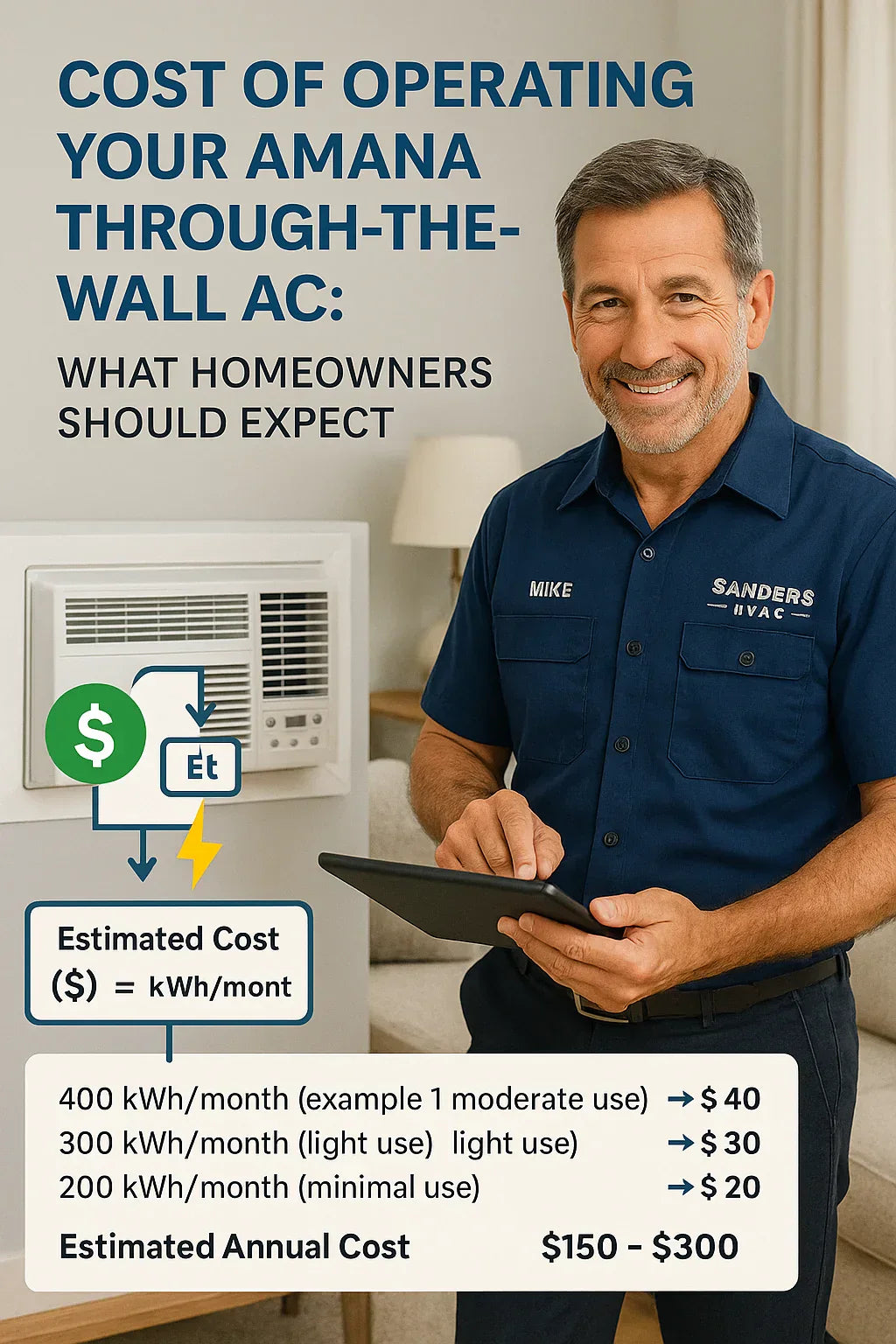💲 Why Understanding Operating Costs Matters
Knowing the true cost of running your Amana 11,900 BTU Through-the-Wall AC with Electric Heat (PBE123J35AA) helps homeowners like Mike Sanders:
-
Budget accurately for summer and shoulder seasons
-
Compare costs with window ACs or central systems
-
Optimize usage for energy savings
The U.S. Department of Energy emphasizes understanding appliance energy use to reduce unnecessary expenses while maintaining comfort.
⚡ Key Factors Impacting Operating Costs
1️⃣ Energy Efficiency (EER): Higher EER units use less electricity.
2️⃣ Local Electricity Rates: Average rates vary from $0.10 to $0.30 per kWh in the U.S.
3️⃣ Usage Hours: Daily and seasonal runtime.
4️⃣ Thermostat Settings: Lower settings use more power.
5️⃣ Room Conditions: Insulation and sun exposure affect runtime.
6️⃣ Filter and Coil Maintenance: Clean units operate efficiently, reducing costs.
📊 Estimated Cooling Costs
The Amana PBE123J35AA typically consumes around 1,000–1,100 watts per hour while cooling.
At $0.15 per kWh:
-
Hourly: $0.15–$0.17
-
8 hours/day: $1.20–$1.36
-
30 days: $36–$41
-
Full season (4 months): $144–$164
Using programmable thermostats and ceiling fans can further lower runtime and costs.
For precise estimates, use the Energy Star energy savings calculator.
♨️ Electric Heat Operating Costs
The electric heat function on the Amana unit uses approximately 1,500 watts per hour.
At $0.15 per kWh:
-
Hourly: $0.23
-
4 hours/day (shoulder seasons): $0.92
-
30 days: $27.60
-
2 months seasonal use: $55
Because resistance heat is more expensive per BTU than gas or heat pump systems, it is best used for targeted, supplemental heating rather than as a primary heat source.
🛠️ How to Reduce Operating Costs
✅ Clean filters monthly for unrestricted airflow. ✅ Seal air leaks around windows and doors. ✅ Use ceiling fans to circulate cool air. ✅ Install a programmable thermostat to optimize runtime. ✅ Close blinds or curtains to reduce heat gain in summer. ✅ Set the thermostat to 78°F when home, 85°F when away (per DOE recommendations).
Following Energy Saver guidelines can lower your cooling bills by up to 10% annually.
🧮 Comparing Costs: Amana vs. Window AC vs. Central AC
| Feature | Amana Through-the-Wall AC | Window AC | Central AC |
|---|---|---|---|
| Installation | Permanent | Temporary | Whole-house |
| Efficiency | High (EER) | Moderate | Varies (SEER) |
| Operation Cost (room) | Low | Low | Higher for single-room use |
| Noise | Low | Moderate | Low |
| Flexibility | Room-specific | Room-specific | Whole-house |
For cooling one or two rooms, a high-efficiency through-the-wall AC often offers the lowest operational cost with long-term stability, especially when replacing older window units.
✅ Is It Cost-Effective for Your Home?
Using the Amana through-the-wall AC is cost-effective if you:
-
Primarily need to cool specific rooms
-
Want to avoid cooling the entire home unnecessarily
-
Seek high efficiency for lower utility bills
-
Need a heating option for shoulder seasons without relying on central heat
🏡 Real-World Mike Sanders Example
Mike uses his Amana PBE123J35AA in a 450 sq ft home office:
-
Runs 8 hours/day during peak summer.
-
Sees an estimated $40/month increase in electricity, much lower than using the central system.
-
Uses electric heat for 2 hours in the morning during fall for under $15/month.
-
Finds the system affordable, efficient, and effective for targeted comfort.
📲 Ready to Upgrade to Efficient Cooling?
Explore the Amana 11,900 BTU Through-the-Wall AC with Electric Heat (PBE123J35AA) to reduce your energy bills while maintaining reliable comfort.
If you need help assessing your expected operating costs, reach out to our team for personalized calculations for your room size and climate.
This guide aligns with Mike Sanders’ practical focus on affordability, clarity, and energy-smart decisions for homeowners.
In the next topic we will know more about: Filter Cleaning and Maintenance for Your Amana Through-the-Wall AC







